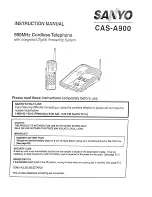
Health and safety information
188
emergency. Remember, it is a free call on your
wireless phone!
9. Use your wireless phone to help others in
emergencies. Your wireless phone provides you
a perfect opportunity to be a °×Good
Samaritan°± in your community. If you see an
auto accident, crime in progress or other serious
emergency where lives are in danger, call 9-1-1
or other local emergency number, as you would
want others to do for you.
10.Call roadside assistance or a special wireless
non-emergency assistance number when
necessary. Certain situations you encounter
while driving may require attention, but are not
urgent enough to merit a call for emergency
services. But you still can use your wireless
phone to lend a hand. If you see a broken-down
vehicle posing no serious hazard, a broken
traffic signal, a minor traffic accident where no
one appears injured or a vehicle you know to be
stolen, call roadside assistance or other special
non-emergency wireless number.
Careless, distracted individuals and people driving
irresponsibly represent a hazard to everyone on the
road. Since 1984, the Cellular Telecommunications
Industry Association and the wireless industry have
conducted educational outreach to inform wireless
phone users of their responsibilities as safe drivers
and good citizens. As we approach a new century,
more and more of us will take advantage of the
benefits of wireless telephones. And, as we take to
the roads, we all have a responsibility to drive
safely.
“The wireless industry reminds you to use your
phone safely when driving.”
Health and safety information
189
Cellular Telecommunications & Internet Association
For more information, please call 1-888-901-SAFE.
For updates: http://www.wow-com.com/consumer/
issues/driving/articles.cfm?ID=85
Appendix C: Consumer Update on
Wireless Phones
U.S. Food and Drug Administration
1. What kinds of phones are the subject of this
update?
The term wireless phone refers here to hand-held
wireless phones with built-in antennas, often called
cell, mobile, or PCS phones. These types of
wireless phones can expose the user to measurable
radiofrequency energy (RF) because of the short
distance between the phone and the user s head.
These RF exposures are limited by Federal
Communications Commission safety guidelines that
were developed with the advice of FDA and other
federal health and safety agencies. When the phone
is located at greater distances from the user, the
exposure to RF is drastically lower because a
person’s RF exposure decreases rapidly with
increasing distance from the source. The so-called
“cordless phones,” which have a base unit
connected to the telephone wiring in a house,
typically operate at far lower power levels, and thus
produce RF exposures well within the FCC’s
compliance limits.
2. Do wireless phones pose a health hazard?











































